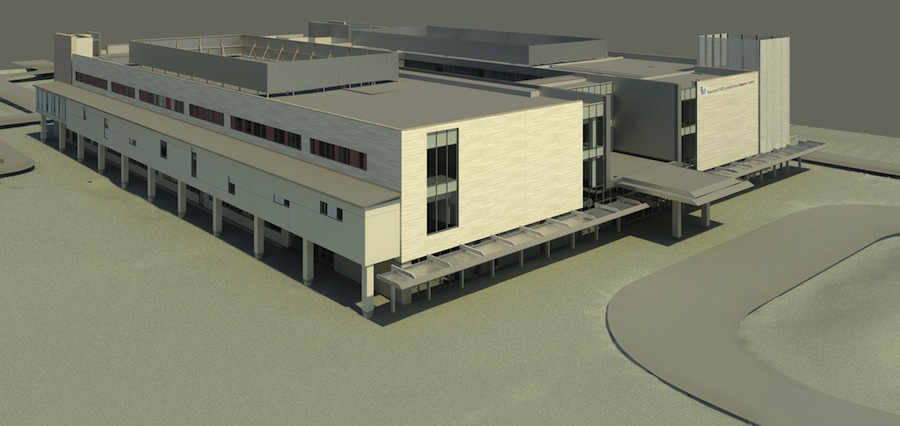Background
HKS, one of the top architectural firms practicing worldwide, specializes in healthcare, education, sports and hospitality design. The firm recently completed the design of phase two of the Banner Health MD Anderson Health Center in Gilbert, Arizona. This three-story, 110,000-square-foot facility provides additional space on the Banner Gateway Medical Center’s campus, which offers state-of-the-art, comprehensive cancer care. Banner Health selected HKS not only for their extensive experience in healthcare design, but also to work collaboratively with all project partners to digitize communication and deliver the facility using IPD.
Challenge
In order to meet the Owner’s IPD goals, HKS needed to digitize and streamline the flow of information to all team members. In the past, the firm had used a combination of solutions to electronically share and review drawings. However, the project’s General Contractor, DPR Construction, suggested the team use Bluebeam Studio throughout design, bid and build. Studio is the online collaboration feature of Revu, a PDF-based markup and collaboration solution that enables users to review large format drawings, redline them with customizable markups, track feedback and collaborate on PDFs with others in real time. Since HKS had already been using Revu’s PDF markup capabilities on other projects for over a year, it made sense to use Studio to host document-based collaboration sessions to foster greater collaboration among the entire project team.
Using Revu for IPD
Though HKS was no stranger to technology, using Revu enabled the firm to improve their workflows in several ways. Revu’s PDF markup technology, which includes customizable annotations such as text, highlights, pen marks, callouts, clouds, CAD symbols and measurements, took electronic commenting to the next level. In addition to providing the team with the ability to redline PDFs, Revu’s exclusive Tool Chest allowed users to save custom markups and easily standardize markup types, fonts and colors. The Markups list, which tracks every comment placed on the PDF, also enabled HKS to keep tabs on who made comments and when, and provided a simple interface for replying to comments.
Additionally, Revu enabled HKS to promote collaboration between multiple parties. By using Bluebeam Studio, HKS held online collaboration sessions with consultants, the GC and Owner. Through Studio Sessions, the team reviewed and redlined a single copy of the same PDF, which was hosted online. Everyone could see each other’s markups, but nobody could change anyone’s comments but their own. The timing of these collaboration sessions was flexible – sometimes the team members met together in real time despite their remote locations, and other times they logged in separately. “On previous projects that didn’t use Revu or Bluebeam Studio, we would have to send multiple versions of drawings from each person and filter through repetitive comments,” said Deva Powell, AIA, LEED AP, Project Architect at HKS. “Studio let everyone view and respond to each other’s comments so it was easy to see who needed to complete a task.”
Results
Using Revu and Bluebeam Studio for IPD was a huge success for HKS and its project partners. In addition to enabling real-time, document-based meetings, Revu eliminated significant paper waste. All project submittals were electronic, and since the Town of Gilbert, Arizona also uses Revu for electronic plan check, the team was able to digitally submit plans for approval.
Compared to solutions that HKS had used in the past for electronic communication, Revu proved to be much more efficient. “The combination of Revu and Bluebeam Studio helped HKS significantly improve the clarity and speed of project communication for the Banner Health MD Anderson Health Center Project, and reduce our printing and shipping costs,” added John Niziolek, AIA, LEED AP, Senior Vice President and Associate Principal at HKS. “We have already begun using Revu on other projects, and our clients are amazed at how quickly we can document items and send updates.”
To learn more about Revu or download a free 30-day trial, please visit us here.
Related Stories
| Oct 17, 2011
USGBC L.A. Chapter's Green Gala to feature Jason McLennan as keynote speaker
Chapter to presents inaugural Sustainable Innovation Awards,
| Oct 17, 2011
Schneider Electric introduces UL924 emergency lighting control devices
The emergency lighting control devices require fewer maintenance costs and testing requirements than backup batteries because they comply with the UL924 standard, reducing installation time.
| Oct 14, 2011
AISC develops new interoperability strategy to move construction industry forward
AISC is working to bring that vision to reality by developing a three-step interoperability strategy to evaluate data exchanges and integrate structural steel information into buildingSMART's Industry Foundation Classes.
| Oct 14, 2011
University of New Mexico Science & Math Learning Center attains LEED for Schools Gold
Van H. Gilbert architects enhances sustainability credentials.
| Oct 14, 2011
BD+C Survey on Building Information Modeling: The Good, the Bad, and the Solutions
In a recent survey conducted by Building Design+Construction, more than 75% of respondents indicated they currently use BIM or plan to use it. Respondents were also asked to comment on their experiences with BIM, what they liked and disliked about BIM, and what BIM-related advice they would give to their peers.
| Oct 14, 2011
ACI partners with CRSI to launch new adhesive anchor certification program
Adhesive anchor installer certification required in new ACI 318-11.
| Oct 14, 2011
Midwest construction firms merge as Black and Dew
Merger is aimed at increasing market sector capabilities and building on communication and core contracting competencies.
| Oct 14, 2011
AIA Continuing Education: optimizing moisture protection and air barrier systems
Earn 1.0 AIA/CES learning units by studying this article and passing the online exam.
| Oct 14, 2011
MaxLite receives 2011 Lighting for Tomorrow honorable mention
The judging panel was particularly impressed with the performance of this fixture.
| Oct 12, 2011
BIM Clarification and Codification in a Louisiana Sports Museum
The Louisiana State Sports Hall of Fame celebrates the sporting past, but it took innovative 3D planning and coordination of the future to deliver its contemporary design.
















